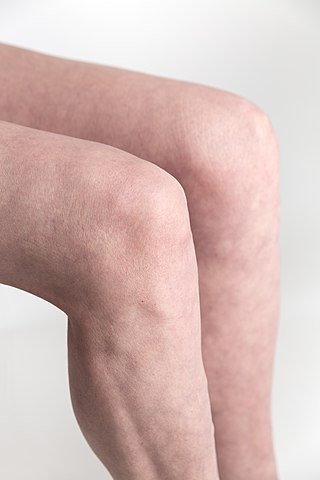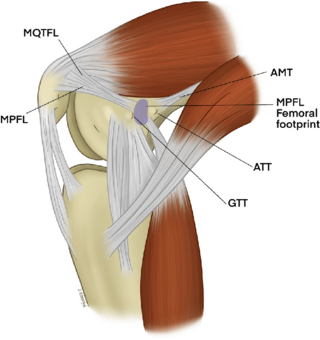Related Research Articles

In humans and other primates, the knee joins the thigh with the leg and consists of two joints: one between the femur and tibia, and one between the femur and patella. It is the largest joint in the human body. The knee is a modified hinge joint, which permits flexion and extension as well as slight internal and external rotation. The knee is vulnerable to injury and to the development of osteoarthritis.

In human anatomy, a hamstring is any one of the three posterior thigh muscles between the hip and the knee.

The posterior cruciate ligament (PCL) is a ligament in each knee of humans and various other animals. It works as a counterpart to the anterior cruciate ligament (ACL). It connects the posterior intercondylar area of the tibia to the medial condyle of the femur. This configuration allows the PCL to resist forces pushing the tibia posteriorly relative to the femur.

The anterior cruciate ligament (ACL) is one of a pair of cruciate ligaments in the human knee. The two ligaments are also called "cruciform" ligaments, as they are arranged in a crossed formation. In the quadruped stifle joint, based on its anatomical position, it is also referred to as the cranial cruciate ligament. The term cruciate translates to cross. This name is fitting because the ACL crosses the posterior cruciate ligament to form an "X". It is composed of strong, fibrous material and assists in controlling excessive motion. This is done by limiting mobility of the joint. The anterior cruciate ligament is one of the four main ligaments of the knee, providing 85% of the restraining force to anterior tibial displacement at 30 and 90° of knee flexion. The ACL is the most injured ligament of the four located in the knee.

The Lachman test is a clinical test used to diagnose injury of the anterior cruciate ligament (ACL). It is recognized as reliable, sensitive, and usually superior to the anterior drawer test.

The Segond fracture is a type of avulsion fracture from the lateral tibial plateau of the knee, immediately below the articular surface of the tibia.
The drawer test is used in the initial clinical assessment of suspected rupture of the cruciate ligaments in the knee.

Anterior cruciate ligament reconstruction is a surgical tissue graft replacement of the anterior cruciate ligament, located in the knee, to restore its function after an injury. The torn ligament can either be removed from the knee, or preserved before reconstruction through an arthroscopic procedure. ACL repair is also a surgical option. This involves repairing the ACL by re-attaching it, instead of performing a reconstruction. Theoretical advantages of repair include faster recovery and a lack of donor site morbidity, but randomised controlled trials and long-term data regarding re-rupture rates using contemporary surgical techniques are lacking.

The vastus medialis is an extensor muscle located medially in the thigh that extends the knee. The vastus medialis is part of the quadriceps muscle group.
The knee examination, in medicine and physiotherapy, is performed as part of a physical examination, or when a patient presents with knee pain or a history that suggests a pathology of the knee joint.

Cruciate ligaments are pairs of ligaments arranged like a letter X. They occur in several joints of the body, such as the knee joint, wrist joint and the atlanto-axial joint. In a fashion similar to the cords in a toy Jacob's ladder, the crossed ligaments stabilize the joint while allowing a very large range of motion.

An anterior cruciate ligament injury occurs when the anterior cruciate ligament (ACL) is either stretched, partially torn, or completely torn. The most common injury is a complete tear. Symptoms include pain, an audible cracking sound during injury, instability of the knee, and joint swelling. Swelling generally appears within a couple of hours. In approximately 50% of cases, other structures of the knee such as surrounding ligaments, cartilage, or meniscus are damaged.

The unhappy triad, also known as a blown knee among other names, is an injury to the anterior cruciate ligament, medial collateral ligament, and meniscus. Analysis during the 1990s indicated that this 'classic' O'Donoghue triad is actually an unusual clinical entity among athletes with knee injuries. Some authors mistakenly believe that in this type of injury, "combined anterior cruciate and medial collateral ligament disruptions that were incurred during athletic endeavors" always present with concomitant medial meniscus injury. However, the 1990 analysis showed that lateral meniscus tears are more common than medial meniscus tears in conjunction with sprains of the ACL.

Mervyn John Cross was an Australian rugby league footballer and orthopaedic surgeon. He played in Australia's major competition the New South Wales Rugby League (NSWRL) but Cross, a doctor, was better known for his achievements in the field of sports medicine as an orthopaedic surgeon.

A tear of a meniscus is a rupturing of one or more of the fibrocartilage strips in the knee called menisci. When doctors and patients refer to "torn cartilage" in the knee, they actually may be referring to an injury to a meniscus at the top of one of the tibiae. Menisci can be torn during innocuous activities such as walking or squatting. They can also be torn by traumatic force encountered in sports or other forms of physical exertion. The traumatic action is most often a twisting movement at the knee while the leg is bent. In older adults, the meniscus can be damaged following prolonged 'wear and tear'. Especially acute injuries can lead to displaced tears which can cause mechanical symptoms such as clicking, catching, or locking during motion of the joint. The joint will be in pain when in use, but when there is no load, the pain goes away.

The medial patellofemoral ligament (MPFL) is one of several ligaments on the medial aspect of the knee. It originates in the superomedial aspect of the patella and inserts in the space between the adductor tubercle and the medial femoral epicondyle. The ligament itself extends from the femur to the superomedial patella, and its shape is similar to a trapezoid. It keeps the patella in place, but its main function is to prevent lateral displacement of the patella.
Posterolateral corner injuries of the knee are injuries to a complex area formed by the interaction of multiple structures. Injuries to the posterolateral corner can be debilitating to the person and require recognition and treatment to avoid long term consequences. Injuries to the PLC often occur in combination with other ligamentous injuries to the knee; most commonly the anterior cruciate ligament (ACL) and posterior cruciate ligament (PCL). As with any injury, an understanding of the anatomy and functional interactions of the posterolateral corner is important to diagnosing and treating the injury.

Medial knee injuries are the most common type of knee injury. The medial ligament complex of the knee consists of:
High tibial osteotomy is an orthopaedic surgical procedure which aims to correct a varus deformation with compartmental osteoarthritis. Since the inception of the procedure, advancements to technique, fixation devices, and a better understanding of patient selection has allowed HTO to become more popular in younger, more active patients hoping to combat arthritis. The idea behind the procedure is to realign the weight-bearing line of the knee. By realigning the knee, the force produced from weight-bearing is shifted from the arthritic, medial compartment to the healthy, lateral compartment. This decrease in force or load in the diseased part of the knee joint decreases knee pain and can delay the development or progression of osteoarthritis in the medial compartment.

The function of the posterior cruciate ligament (PCL) is to prevent the femur from sliding off the anterior edge of the tibia and to prevent the tibia from displacing posterior to the femur. Common causes of PCL injuries are direct blows to the flexed knee, such as the knee hitting the dashboard in a car accident or falling hard on the knee, both instances displacing the tibia posterior to the femur.
References
- ↑ Padua DA, Boiling MC, DiStefano LJ, Onate JA< Beutler AI, Marshall SW. "Reliability of the landing error scoring system-real time, a clinical assessment tool of jump-landing biomechanics." J of Sport Rehabil. 2011;20(2):145-56
- ↑ Padua DA, Marshall SW, Boiling MC, Thigpen CA, Garrett WE, Jr., Beutler AI. "The landing error scoring system (LESS) is a valid and reliable clinical assessment tool of jump-landing biomechanics:The Jump-ACL study." The American Journal of Sports Medicine. 2009;37(10):1996-2002
- ↑ Paterno MV, Schmitt LC, Ford KR, Rauh MJ, Myer GD, Huang B, et al. "Biomechanical measures during landing and postural stability predict second anterior cruciate ligament injury after anterior cruciate ligament reconstruction and return to sport." The American Journal of Sports Medicine. 2010;38(10):1968-78
- ↑ Boiling MC, Padua DA, Marshall SW, Guskiewicz K, Pyne S, Beutler A. "A prospective investigation of biomechanical risk factors for patellofemoral pain pain syndrome: the Joint Undertaking to Monitor and Prevent ACL injury (Jump-ACL) cohort." The American Journal of Sports Medicine. 2009;37(11):2108-16
- ↑ Boiling MC, Padua DA. "Relationship between hip strength and trunk, hip and knee kinematics during a jump-landing task in individuals with patellofemoral pain." International journal of sports physical therapy. 2013;8(5):661-9
- ↑ Beutler A, de la Motte S, Marshall S, Padua D, Boden B. "Muscle strength and qualitative jump-landing differences in male and female military cadets: The Jump-ACL study." Journal of Sports Science and Medicine. 2009;8:663-71
- ↑ Boiling MC, Padua DA. "Relationship between hip strength and trunk, hip and knee kinematics during a jump-landing task in individuals with patellofemoral pain." International journal of sports physical therapy. 2013;8(5):661-9
- ↑ Blackburn JT, Padua DA. "Influence of trunk flexion on hip and knee joint kinematics during a controlled drop landing." Clin Biomech (Bristol, Avon). 2008;23(3):313-9
- ↑ Goekler A, Eppinga P, Dijkstra PU, Welling W, Padua D, Otten E, et al. "Effect of fatigue on landing performance assessed with the landing error scoring system (LESS) in patients after ACL reconstruction. A pilot study." The International Journal of Sports Physical Therapy. 2014;9(3):302-11
- ↑ Beutler A, de la Motte S, Marshall S, Padua D, Boden B. "Muscle strength and qualitative jump-landing differences in male and female military cadets: The Jump-ACL study." Journal of Sports Science and Medicine. 2009;8:663-71
- ↑ Padua DA, Frank B, Donaldson A, de la Motte S, Cameron KL, Beutler AI, et al. "Seven steps for developing and implementing a preventive training program: lessons learned from Jump-ACL and beyond." Clinics in Sports Medicine. 2014;33(4):615-32
- ↑ "FMS valoración funcional del movimiento y su importancia". mundoentrenamiento.com (in Spanish). Retrieved 2024-04-17.
- ↑ "FMS valoración funcional del movimiento y su importancia". mundoentrenamiento.com (in Spanish). Retrieved 2024-04-17.
- ↑ "FMS valoración funcional del movimiento y su importancia". mundoentrenamiento.com (in Spanish). Retrieved 2024-04-17.
- ↑ Pomares, Gloria (2023-06-30). "Pruebas de valoración del equilibrio más utilizadas en rehabilitación". Rehametrics (in European Spanish). Retrieved 2024-04-17.
- ↑ Pierdepesoencasa (2023-12-22). "Importancia de evaluar y analizar la calidad del movimiento: FMS, goniometría y testeos posturales". Pierde peso en casa (in Spanish). Retrieved 2024-04-17.
- ↑ Rivero, Paula (2022-04-11). "Test de Adams, una maniobra para detectar la escoliosis en casa". Consejos de tu Farmacéutico (in Spanish). Retrieved 2024-04-17.
- ↑ Liebenson C. "Functional Exercises." Journal of Bodywork and Movement Therapies. 2002; April
- ↑ Crossley KM, Zhang WJ, Schache AG, Bryant A, Cowan SM. "Performance on the single-leg squat task indicates hip abductor muscle function." The American Journal of Sports Medicine. 2011;39(4):866-73
- ↑ Bailey R, Selfie J, Richards J. "The single leg squat test in the assessment of musculoskeletal function: A review." Physiotherapy Ireland.2010;31(1):18-23.
- ↑ Livengood A, DiMattia M, Uhl T. "Dynamic Trendelenburg: Single-leg squat for gluteus medius strength." Athletic Therapy Today. 2004;9(1):24-5.
- ↑ Barber SD, Noyes FR, Mangine RE, McCloskey JW, Hartman W."Quantitative assessment of functional limitations in normal and anterior cruciate ligament-deficient knees." Clinical Orthopaedics and Related Research. 1990;255:204-14
- ↑ Fitzgerald GK, Lephart SM, Hwang JH, Wainner RS. "Hop tests as predictors of dynamic knee stability." The Journal of Orthopaedic and Sports Physical Therapy. 2001;31(10):588-97
- ↑ Itoh H, Kurosaka M, Yoshiya S, Ichihashi N, Mizuno K. "Evaluation of functional deficits determined by four difference hop tests in patients with anterior cruciate ligament deficiency." Knee Surgery, Sports Traumatology, Arthoscopy: Official Journal of the ESSKA. 1998;6(4):241-5.
- ↑ Noyes FR, Barber SD, Mangine RE. "Abnormal lower limb symmetry determined by function hop tests after anterior cruciate ligament rupture." The American Journal of Sports Medicine. 1991;19(5):513-8
- ↑ Rudolph KS, Axe MJ, Snyder-Mackler L. "Dynamic stability after ACL injury: Who can hop?" Knee Surgery, Sports Traumatology, Arthoscopy: Official Journal of the ESSKA. 2000;8(5):262-9.
- ↑ Augustsson J, Thomee R, Linden C, Folkesson M, Tranberg R, Karlsson J. "Single-leg hop testing following fatiguing exercise: reliability and biomechanical analysis." Scandinavian Journal of Medicine and Science in Sports. 2006;16(2):111-20.
- ↑ Logerstedt D, Grindem H, Lynch A, Eitzen I, Engebretsen L, Risbger MA, et al. "Single-legged hop tests as predictors of self-reported knee function after anterior cruciate ligament reconstruction: The Delaware-Oslo ACL cohort study." The American Journal of Sports Medicine. 2012;40(10)"2348-56.
- ↑ Briem K, Axe MJ, Snyder-Mackler L. "Medial knee joint loading increases in those who respond to hyaluronan injection for medial knee osteoarthritis." Journal of orthopaedic research: Official publication of the Orthopaedic Research Society. 2009;27(11):1420-5.
- ↑ Barber SD, Noyes FR, Mangine RE, McCloskey JW, Hartman W."Quantitative assessment of functional limitations in normal and anterior cruciate ligament-deficient knees." Clinical Orthopaedics and Related Research. 1990;255:204-14
- ↑ Augustsson J, Thomee R, Linden C, Folkesson M, Tranberg R, Karlsson J. "Single-leg hop testing following fatiguing exercise: reliability and biomechanical analysis." Scandinavian Journal of Medicine and Science in Sports. 2006;16(2):111-20.
- ↑ Logerstedt D, Grindem H, Lynch A, Eitzen I, Engebretsen L, Risbger MA, et al. "Single-legged hop tests as predictors of self-reported knee function after anterior cruciate ligament reconstruction: The Delaware-Oslo ACL cohort study." The American Journal of Sports Medicine. 2012;40(10)"2348-56.
- ↑ Gustavsson A, Neeter C, Thomee P, Silbernagel KG, Augustsson J, Thomee R, et al. "A test battery for evaluating hop performance in patients with an ACL injury and patients who have undergone ACL reconstruction." Knee Surgery, Sports Traumatology, Arthoscopy: Official Journal of the ESSKA. 2006;14(8):778-88.
- ↑ Grindem H, Logerstedt D, Eitzen I, Moksnes H, Axe MJ, Snyder-Mackler L, et al. "Single-legged hop tests as predictors of self-reports knee function in non-operatively treated individuals with anterior cruciate ligament injury." The American Journal of Sports Medicine. 2011;39(11):2347-54.
- ↑ Bizzini M, Hancock D, Impellizzeri F. "Suggestions from the field for return to sports participation following anterior cruciate ligament reconstruction: Soccer." The Journal of orthopaedic and sports physical therapy. 2012;42(4):304-12.
- ↑ Myer GD, Paterno MV, Ford KR, Hewett TE. "Neuromuscular training techniques to target deficits before return to sport after anterior cruciate ligament reconstruction." Journal of strength and conditioning research/National Strength & Conditioning Association. 2008;22(3):987-1014.
- ↑ Thomee R, Kaplan Y, Kvist J, Myklebust G, Risberg MA, Theisen D, et al. "Muscle strength and hop performance criteria prior to return to sports after ACL reconstruction. Knee Surgery, Sports Traumatology, Arthoscopy: Official Journal of the ESSKA. 2011;19(11):798-805.